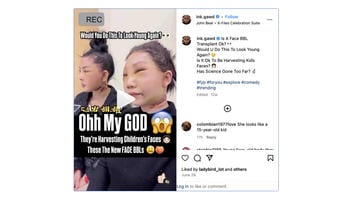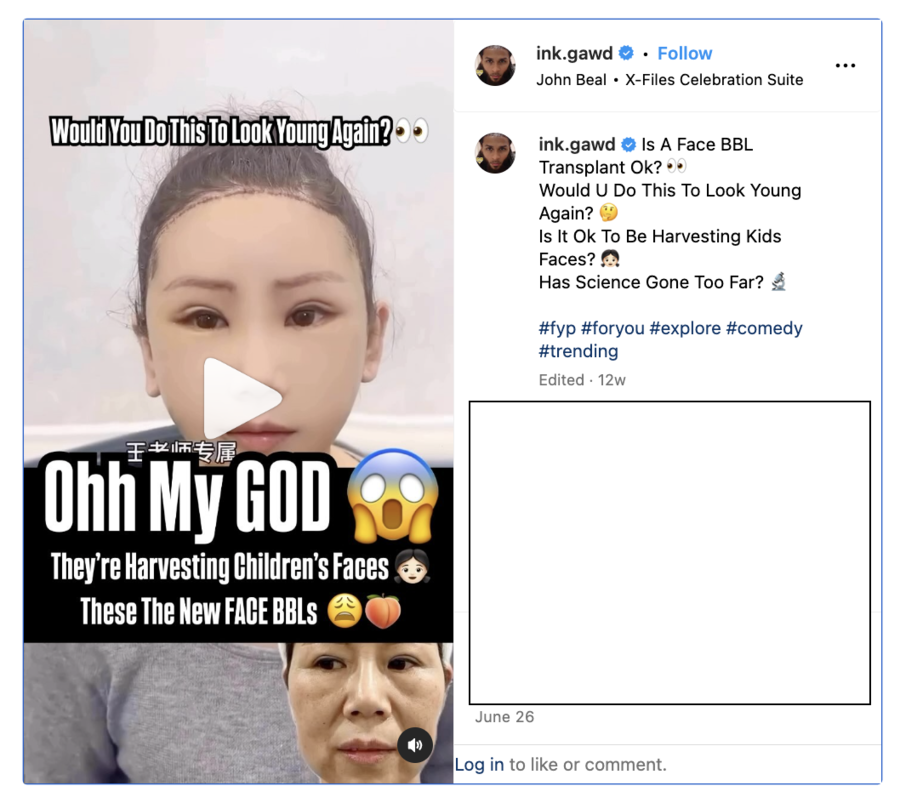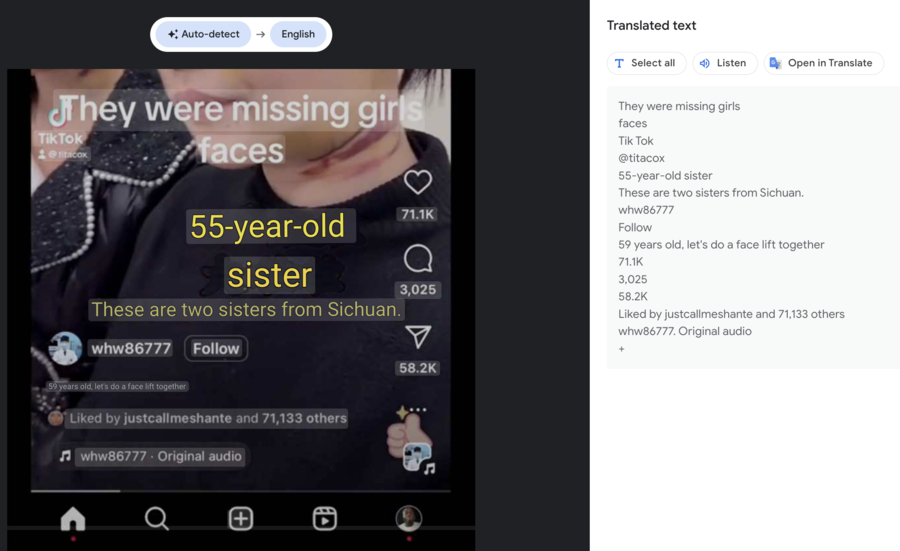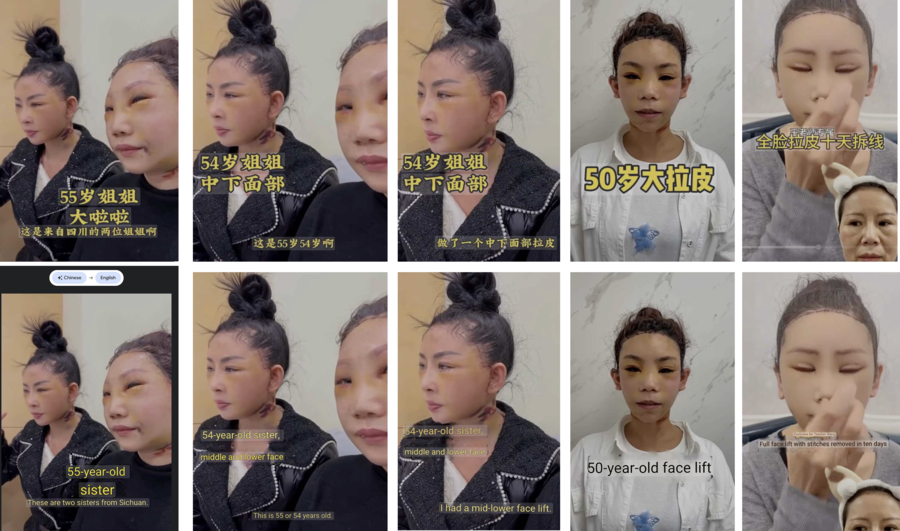
Does a viral video offer evidence that children's faces are being "harvested" in China or anywhere in the world to be transplanted onto female recipients trying to look younger? No, that's not true: Both Mandarin subtitles and original voice-overs in the video discussed facelifts -- a much more common surgical procedure that doesn't require any other person's face. Face transplants do take place, but rarely, with only one occurring in China. Unlike cosmetic facelifts, which aim to make patients look younger, face transplants are reserved for cases of severe physical trauma to the face that cannot be treated with reconstructive plastic surgery.
The claim appeared in a video (archived here) on Instagram on June 26, 2024, under the caption:
Ohh My GOD 😱
They're Harvesting Children's Faces 👧🏻
These The New Face BBLs 🍑😩
The caption continued:
Is A Face BBL Transplant Ok? 👀
Would U Do This To Look Young Again? 🤔
Is It Ok To Be Harvesting Kids Faces? 👧🏻
Has Science Gone Too Far? 🔬
#fyp #foryou #explore #comedy #trending
This is what the post looked like on Instagram at the time of writing:
(Source: Instagram screenshot taken on Mon Sep 23 15:02:47 2024 UTC)
The post and video gave no evidence to substantiate the claim of "harvesting" faces from children. The implication of the video was that the women shown were recipients.
The video was a compilation of several clips portraying female patients in what appeared to be post-surgery recovery, with medical sutures still visible on their faces. The original sound in the footage was replaced with music.
The earliest variation of the claim found by Lead Stories is on March 26, 2024 (archived here). In that post on TikTok, the video showed the details of the account that had published it earlier: @whw86777. That creator described themselves as "Shanghai Plastic Surgeon Dr. Wang" on YouTube (archived here). As of this writing, accounts with the same handle were also present on Instagram (archived here) and TikTok (archived here), but the original video appeared to have been deleted.
The March 26, 2024, video contained Chinese subtitles (in yellow) seen between English lines that were added. As translated by Google, the Chinese subtitles referred to facelifts said to have been performed on patients in their 50s:
(Source: Google Translate screenshot taken on Mon Sep 23 17:28:01 2024 UTC)
Another variation of the claim published on May 31, 2024 (archived here), utilized a better-quality version of the video where subtitles were not covered with other, apparently later added graphic elements (click to view larger):
(Sources: Top row: Instagram screenshots taken on Mon Sep 23 17:07:14-17:09:37 2024 UTC; bottom row: Google Lens screenshots taken on Mon Sep 23 17:12:23-17:21:42 2024 UTC; composite image by Lead Stories)
Lead Stories browsed across numerous duplicates of the claim and its variation, but they had sound changed to either music or English narration.
However, Lead Stories discovered two clips with Mandarin voice-overs from the longer video that appeared in the post that is the focus of this fact check. The clips showed the first two "sisters" (archived here and here) and the last woman (archived here) from the sequence seen in the screenshot above.
Han Chen, a Mandarin-speaking journalist based in Washington, D.C., translated them at the request of Lead Stories, adding that the Mandarin voice-overs were "mostly consistent" with subtitles and that "the woman in the second video definitely sounds lip-synced":
Video #1
Female in background: (They are) so cute!
Male in background: These two sisters come from Sichuan province.
(Panning the camera.) The one on the right is 55, and the one on the left is 54.
The 54-year-old had a SMAS facelift, while the 55-year-old had a full facelift.
Today marks the fifth day (post-surgery) for them.
Video #2
Female in background: Is this your seventh day (post-surgery)?
Female on camera: Yea.
Male in background: Let me check how it looks now.
Where are you from, little sister?
Female on camera: Anhui province.
Male in background: Anhui. I see.
Today marks the ninth day since your facelift surgery. Is that right?
Female on camera: Yea.
Male in background: Take a look at the results. Are you satisfied overall?
Female on camera: Yea.
Lead Stories was not able to identify the women in the videos or confirm whether the footage authentically portrayed the outcomes of those surgeries.
According to a 2021 BBC report (archived here), the cosmetic surgery industry grew three times faster in China than the respective global market in the years preceding the pandemic, despite tens of thousands of reports of botched surgeries performed at unlicensed facilities. As the article pointed out, cosmetic surgeries were commonly advertised on social media apps designed specifically for that purpose.
Unlike facelifts, face transplants are rare. Between November 2005 when the first patient received the face of a deceased donor and August 2020, this surgery was performed only 47 times in all countries combined, according to a 2021 scholarly article (archived here) published by the Journal of the History of Medicine and Allied Sciences.
It reads:
No more than six transplants have taken place globally in any one year, with a cluster of 27 transplants occurring between 2009 and 2013. These five years alone accounted for over half of all transplants conducted. They have taken place at 21 hospitals worldwide in 11 countries but only half of those teams have conducted more than one transplant. Indeed, thirty-three of the transplants have taken place in three countries alone: the USA, France and Turkey. Two surgeons account for over a third between them: Bohdan Pomahac at Brigham and Women's Hospital in Boston (9 transplants, 2009-2019) and Laurent Lantieri at Henri Mondor Hospital in Paris (8 transplants, 2008-2018).
An appendix attached to the study showed that only one -- partial -- donor face transplant was performed in China in 2006 (archived here).
A 2023 study (archived here) published in the Journal of Plastic, Reconstructive and Aesthetic Surgery listed 48 confirmed face transplantation surgeries performed on 46 patients. China's share was still one surgery of this type.
(The two studies cited above analyzed confirmed cases when a face was received from a donor -- not when tissues were transplanted from other parts of a patient's body to their faces.)
Face-transplant cases tend to be heavily covered by media organizations.
Had China had four successful donor face transplantations in recent years, that would have been reported in the news. But a search across Google News for the keywords seen here (archived here) shows no articles confirming that.
A search for the keyword "face transplant" on YouTube leads to many videos published by credible sources that portray the "before" and "after" stages. For example, here is a video produced by the Cleveland Clinic (archived here), and here are news packages by CBS (archived here) and by the AP (archived here).
A review of that footage makes it self-evident that while donor face transplantations may help recipients improve their quality of life, the outcomes are very different from anti-aging facelifts.
In part, that is because face transplants are much more complex surgeries restricted to patients with severe trauma to their faces.
The website of the clinical practice for the Yale School of Medicine (archived here) reads:
For a person to consider a face transplant, facial disfigurement is typically so extensive that it interferes with their ability to talk, chew, swallow, blink, and even make simple facial expressions like smiling or grimacing. One of the main goals of face transplant surgery is to restore these functions and give people control over the movement of the mouth, nose, eyelids, and other parts of the face.
... it's a complex procedure that often involves not only transplantation of the skin, but also of the underlying bones, cartilage, tendons, ligaments, muscles, nerves, and blood vessels.
Face transplants may not always fully undo the traumatic damage to the facial tissues, as seen in a photo gallery published by the National Geographic (archived here) and CBS (archived here).
The claim that is the focus of this fact check circulated in several languages, including Spanish (archived here), French (archived here), Japanese (archived here), Turkish (archived here), Arabic (archived here) and Russian (archived here).
In the U.S., it was boosted (archived here) by a popular account known for spreading QAnon conspiracies (archived here).
Lead Stories has debunked numerous examples of similar unsubstantiated narratives from QAnon.
Lead Stories fact checks discussing other international topics can be found here. Stories about health are here.


















